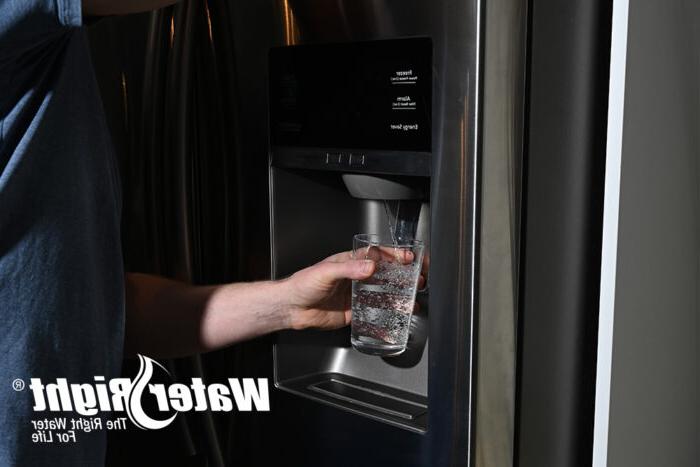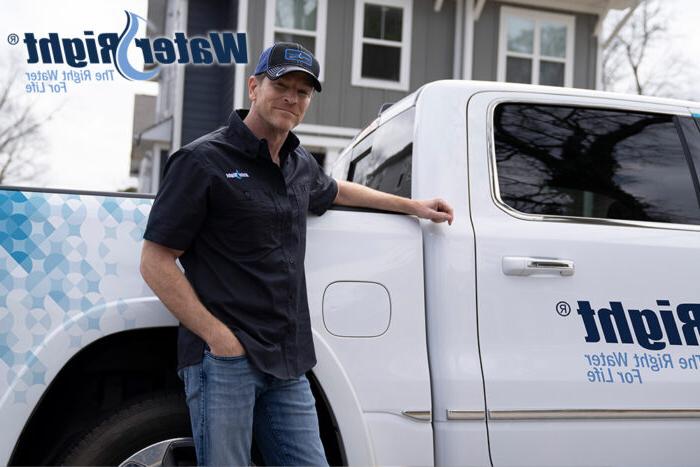If you’ve been dealing with soap scum buildup or mineral crust on your shower heads, you have likely figured out you have hard water and need to treat it with a water softener for long lasting results — but what is a water softener, and how does a water softener work?
For those unfamiliar with how to treat hard water, having a water softener installed may seem daunting and expensive. However, the good news is that in most cases, water softeners can easily be added to your existing plumbing — and often at a lower price than homeowners may realize. Though there are a number of different styles and brands of water softeners, a typical water softener is an appliance that involves storage for salt and a media tank that softens the water (most styles are smaller than a refrigerator). Before we dig into how a water softener works, let’s review what is it that makes water our “hard.”
Hard Water vs. Soft Water
Regardless of whether your home’s water comes from a private well or it’s piped to your home from your local municipality, there’s more in your home’s water than just H2O. Both sources are known to contain hardness minerals, which is what makes some water “harder” than others. Calcium and magnesium are the most common minerals found in water. Typically, minerals get there because groundwater will dissolve rock like limestone, or metals, like iron, and the remnants travel with the water.
It is common for people on private wells to have “harder” water than public water as a municipality’s treatment process can inadvertently eliminate some of the hardness minerals as part of their normal filtration and treatment process. With that said, nearly 90% of homes across the United States will have hard water, and most municipalities do not treat water for hardness.
The minerals that create hard water can cause a scaly buildup on everything from dishes to pipes, to the heating elements of your appliances, to your own body. Soap scum and clogged plumbing are usually the result of hard water.
In the most basic sense, a water softener in effect “softens” the water by capturing those hard minerals before the water flows through your home to be used. This makes it easier to clean your home and your laundry, while prolonging the life of appliances that use water. Let’s take a look at the science behind how a water softener works.
How Hard Water Becomes Soft — The Ion Exchange Process
Regardless of whether your home’s water comes from a private well or it’s piped to your home from your local municipality, there’s more in your home’s water than just H2O. Both sources are known to contain hardness minerals, which is what makes some water “harder” than others. Calcium and magnesium are the most common minerals found in water.
Typically, minerals get there because groundwater will dissolve rock like limestone, or metals, like iron, and the remnants travel with the water. It is common for people on private wells to have “harder” water than public water as a municipality’s treatment process can inadvertently eliminate some of the hardness minerals as part of their normal filtration and treatment process. With that said, nearly 90% of homes across the United States will have hard water, and most municipalities do not treat water for hardness.
The minerals that create hard water can cause a scaly buildup on everything from dishes to pipes, to the heating elements of your appliances, to your own body. Soap scum and clogged plumbing are usually the result of hard water.
In the most basic sense, a water softener in effect “softens” the water by capturing those hard minerals before the water flows through your home to be used. This makes it easier to clean your home and your laundry, while prolonging the life of appliances that use water. Let’s take a look at the science behind how a water softener works.
The Ion Exchange Process in Water Softening

In order to have an ion exchange, and thus be able to soften our water, there has to be a media or environment that all creates the conditions for that to happen. The media our water softeners use is either ion-exchange resin beads or zeolite, which is a special inorganic mineral that comes in the form of tiny crystals. Learn more about our exclusive zeolite material at Mineral-Right.com.
Each resin bead or zeolite crystal is negatively charged and has space to hold on to positive ions. The fresh media starts by holding on to the positively charged sodium ions. As hard water passes through your water softener tank, the stronger charged calcium or magnesium are pulled to the media like a magnet. Since the hardness minerals have a higher positive charge than the sodium, they will knock the sodium ions off and take their place.
All the hardness minerals stay trapped inside the water softener tank while the H2O, with a few sodium ions, disperse throughout your home for use. The water that is dispersed throughout your home no longer has all the hard minerals that cause scaly buildup and other problems!
It’s important to remember that soft water is not salt water, as it only contains a small amount of sodium due to the ion exchange process. The trace amount of salt that remains would be less than eating two ounces of cheddar cheese!
In the animation below, you can see how a water softener works. The water flows from the external source, through the media that removes minerals, and then provides your home with softened water.
Watch How a Water Softener Works
You may be wondering what happens to the hardness minerals that are trapped inside your softener’s tank. If all the media beads or crystals are full of the calcium, magnesium, etc., how can treatment more water in the future? That’s where the second part of the water softening process takes place: Regeneration!
Ion Exchange During Regeneration

The regeneration process usually happens in the middle of the night when your family is asleep and nobody needs to use any water.
Regeneration – How Water Softeners Keep Working
Regeneration is how a water softening system cleans and recharges itself so it can continue providing your home with soft water. As you’ll recall, the water softener has two main components: the tank in which the ion exchange occurs and a secondary salt storage tank.
The secondary storage tank is where the homeowner will need to add water softener salt. Water is added to the tank to create a salt solution called brine, and often, this component is known as the brine tank. During regeneration, the water softener will take the brine solution into the softener tank, and the ion exchange process happens again, only this time in reverse.
The media gets a bath in the salt solution. Hard minerals caught in the resin (or zeolite) are released and the media gets replenished with sodium ions. The water softener is also cleaned and disinfected during regeneration. Finally, water containing the hard minerals and other waste gets flushed out of the system.
Your water softener works through the ion exchange process, reducing hard water and recharging the system through another ion exchange in the brine solution. Although your water softener will continue to work with little attention needed from the homeowner (other than adding salt), it is advised to conduct preventive maintenance by having your water softener checked out regularly.
How Do I Know If I Need a Water Softener?
If you notice a lot of soap scum around your home, if your towels are hard and stiff, or if you have a hard time getting a nice sudsy lather in the shower… you may have hard water problems.
Some people think water softeners are only necessary if you have a private well with extremely hard water. The reality is that hard water — no matter what degree of hardness — can negatively impact you and your home and it is not something that your city will remove before providing water to their residents. Many people who live in a city or village with municipality-supplied water can have hard water coming from the tap. Municipalities are required to treat the water for impurities, but they typically do not remove hardness minerals because they are not harmful to your health.
If you do have a well, you may need other types of filtration to improve the water quality as well since you are not getting water pre-treated by a municipality. Getting your water hardness tested by your local water treatment expert will help you determine how hard your water is and what type of a system you need.
Why You Should Care if Your Home Has a Water Softener
Hard water can cause significant problems in your home and for you personally. When it comes to your plumbing and appliances, hard water build up can degrade their performance and longevity. The modern home depends on soft water. High efficiency appliances can not run as designed when they suffer from hard water build up. Dishwashers and washing machines could end up with a much shorter lifespan because hard water can erode important parts, causing them to prematurely break down or stop functioning altogether.
Hard water can also make it harder to keep your home clean as typical household cleaners will have a difficult time performing in hard water. Staining in sinks, showers, and bathrooms along with mineral crusts on shower heads and faucets can make an otherwise clean space look dirty.
Individually, hard water can also negatively impact your hair and skin. Those with hard water are more susceptible to having dry skin, and it can also make hair frizzy, dry, and lifeless as a result of buildup. At the end of the day, it is important to have a water softener as hard water can wreak havoc on your plumbing, your hair and skin, and make it harder to keep the house clean. Now that you know how a water softener works and who needs one, you can take the steps to find a water softener company near you, get your water tested, and have your hard water treated as necessary.
Find the right contractor for you.
Recent Homeowner Resources

Can In-line Filtration Fix All Water Problems?

What To Look For In Your Water Softening Equipment Provider?



